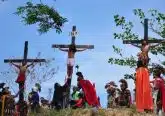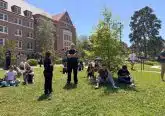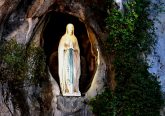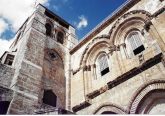Vast distances create trials and joy for Catholics in mission dioceses

IMAGE: CNS photo/Chaz Muth
By Chaz Muth
DRIGGS, Idaho (CNS) — Father Adrian Vazquez bolted out of his rectory in St. Anthony on a cold November morning, brushed a thin layer of snow off of his Subaru Outback, started the engine and raced down the road to make the 50-mile drive to his mission chapel in Driggs.
The scenery along the way was stunning, with spectacular vistas of the Grand Teton mountain range.
Father Vazquez said he never gets tired of being surrounded by the rustic beauty of rural eastern Idaho.
It’s the amount of driving he does each week that wears on him.
He makes the 100-mile round-trip drive to Driggs at least twice a week to tend to his flock.
That’s in addition to 30-mile-round-trip drive Father Vazquez makes to another mission chapel in Rexburg and the 85-mile-round-trip drive to another in Island Park.
That’s right, this priest is the administrator of Mary Immaculate Catholic Church in St. Anthony and three mission chapels located in about a 200-mile radius.
Seem like an enormous job for one U.S. priest?
It’s not uncommon in U.S. Catholic home mission dioceses for a lone cleric to care for several faith communities spread out over great distances.
“Some of our priests in our country put on 50,000 miles a year to get to these parishes so they can bring the sacraments and teach the word of God, as do other catechists and lay leaders,” said Boise Bishop Peter F. Christensen.
The early American missionaries also traveled extensively to bring Catholicism to small populations spread out over great distances, a tradition that helps keep the faith vibrant in rural areas today, Bishop Christensen told Catholic News Service during an interview in Boise.
Some of today’s priests travel in nontraditional ways to reach their faith communities.
For instance, in Alaska, where the roads don’t always connect to the towns, church leaders have been known to kayak to their mission chapels and others are required to fly, said Juneau Bishop Edward J. Burns.
Shortly after Bishop Burns arrived in Alaska to assume leadership of the diocese in 2009, his new staff gave him a parish visit itinerary. When he asked what time Mass began at St. Francis Chapel in Tenakee Springs, they laughed and told him that it started when he arrived.
“To go out to Tenakee Springs, I had to go out to the dock to get onto the float plane. … It takes off and we fly 20 to 25 minutes out to the village,” he said. “Well, the people there hear the float plane arrive … so the people don’t gather at the chapel until 20 minutes after the plane lands. So, the plane becomes the modern-day church bell.”
Spending many hours behind the wheel of a car does create hazards for priests in home mission dioceses, said Lynne Green, a parishioner of Good Shepherd Catholic Church in Driggs.
The long hours of ministry and driving caused her former pastor to fall asleep at the wheel on his way home from Mass one evening, and though it ended up being a minor accident, it made Green aware of some of the vulnerabilities involved in this kind of pastoral care.
“It’s difficult,” she said. “Our priests are stressed. A lot of them end up completely burned out by the time they finish with this assignment.”
The burden of distance doesn’t just fall on church leaders. Many loyal parishioners, like Anatolia Romero of Shoshone and her family, drive 45 minutes or longer each way to get to church.
Romero and her husband routinely work 12 hours a day as ranch hands but make the 45-minute drive to Jerome two to three times a week to attend Mass at St. Jerome Catholic Church, take their children to religion class, attend social events and help out with funerals.
“I don’t see the time as a sacrifice,” she said following an October social function at the parish. “We need to be here. We need to be here for God. We need to be here for us. It’s like home for us. It’s where we belong.”
In some ways, the long travel times encourage parishioners to invest a deeper commitment to the church, said Father Rob Irwin, pastor of St. Jerome.
Since it takes so long to travel to the church, these parishioners are not in a hurry to drive home, so they spend more time in the parish socializing, participating in other events, becoming active in the parish council, volunteering in social ministry or taking faith-enrichment classes, Father Irwin said.
“It’s a special privilege … to have people come in from great distances, to experience this missionary faith,” he said. “People make a choice to come and make a choice to be engaged and involved. We don’t take them for granted. Neither do they take their faith for granted.”
– – –
Follow Chaz Muth on Twitter: @Chazmaniandevyl.
– – –
Copyright © 2016 Catholic News Service/U.S. Conference of Catholic Bishops. www.catholicnews.com. All rights reserved. Republishing or redistributing of CNS content, including by framing or similar means without prior permission, is prohibited. You may link to stories on our public site. This copy is for your personal, non-commercial use only. To request permission for republishing or redistributing of CNS content, please contact permissions at [email protected].













